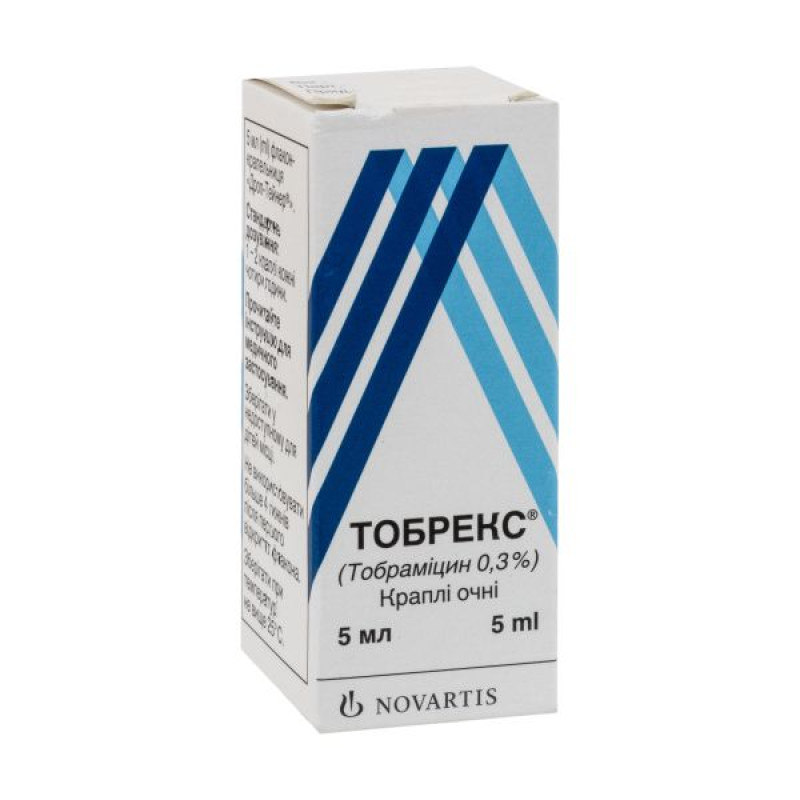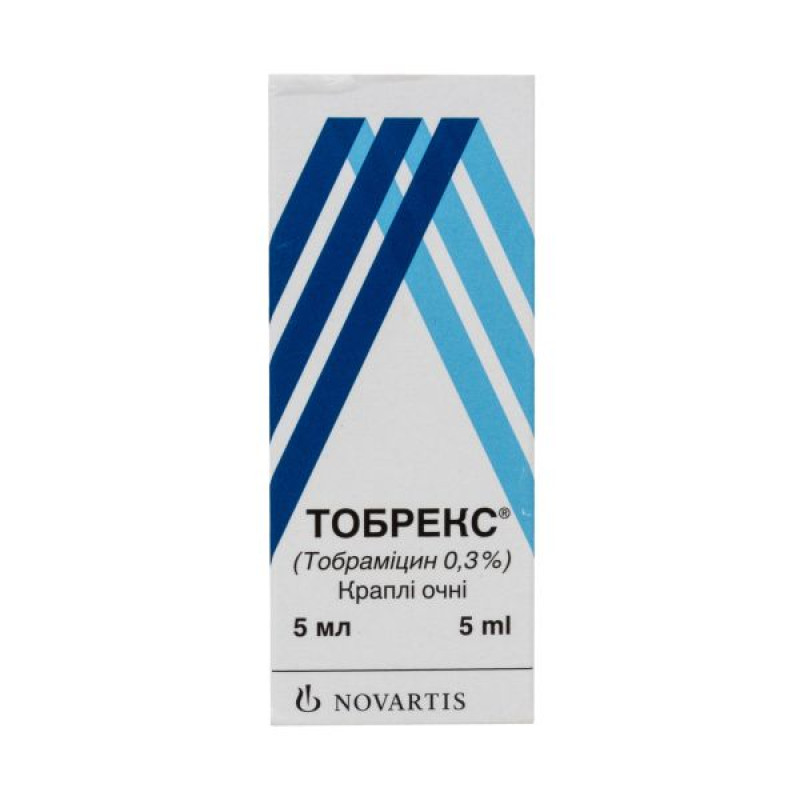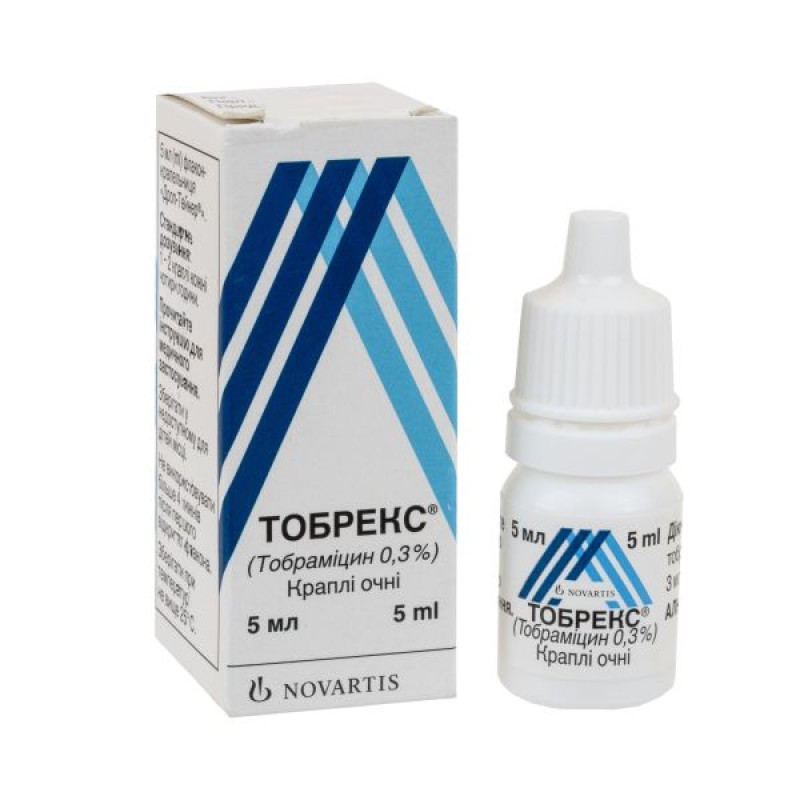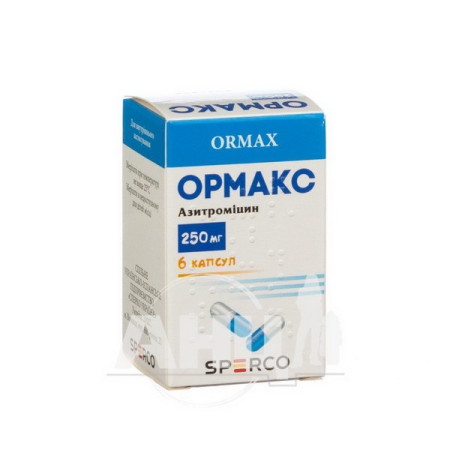Tobrex eye drops 0.3% bottle 5 ml

Instructions for use Tobrex eye drops 0.3% bottle 5 ml
Composition
active ingredient: 1 ml of solution contains tobramycin 3 mg;
excipients: benzalkonium chloride, boric acid, anhydrous sodium sulfate, sodium chloride, tyloxapol, sulfuric acid and/or sodium hydroxide, purified water.
Dosage form
Eye drops.
Main physicochemical properties: clear solution from colorless to pale yellow or brown.
Pharmacotherapeutic group
Means used in ophthalmology. Antimicrobial agents. Antibiotics. ATX code S01A A12.
Pharmacological properties
Pharmacodynamics
Tobramycin is a fast-acting bactericidal antibiotic of the aminoglycoside group. Its main action is directed at bacterial cells and consists in inhibiting the polypeptide complex and synthesis in ribosomes.
Resistance to tobramycin has several different mechanisms of occurrence, including alterations in the ribosomal subunits in the bacterial cell, impaired transport of tobramycin into the cell, and inactivation of tobramycin by a group of adenylating, phosphorylating, and acetylating enzymes. Genetic information for the production of inactivating enzymes can be carried in bacterial chromosomes or plasmids. Cross-resistance to other aminoglycosides is possible.
The following breakpoints and in vitro activity spectrum are based on systemic administration. These values may not be applicable when the medicinal product is administered topically to the eye, as higher concentrations are achieved with topical administration and local physical/chemical conditions may affect the activity of the medicinal product at the site of administration. According to the European Committee on Antibiotic Susceptibility Testing (EUCAST), the following breakpoints have been established for tobramycin:
Enterobacteriaceae S ≤ 2 mg/l, R > 4 mg/l,
Pseudomonas spp.S ≤ 4 mg/l, R > 4 mg/l,
Acinetobacter spp.S ≤ 4 mg/l, R > 4 mg/l,
Staphylococcus spp. S ≤ 1 mg/l, R > 1 mg/l,
Non-species-specific S ≤ 2 mg/l, R > 4 mg/l.
The information below provides an indication of whether microorganisms will be susceptible to tobramycin in TOBREX®. The instructions only list the types of bacteria that commonly cause external eye infections, such as conjunctivitis.
The prevalence of acquired resistance may vary geographically and over time for the relevant species of micro-organisms, therefore it is advisable to have local information on the resistance of microorganisms, especially when treating severe infections. If necessary, specialist advice should be sought if the local prevalence of resistance is such that the activity of tobramycin, at least against some species of infections, is questionable.
Sensitive species
Aerobic Gram-positive microorganisms
Bacillus megaterium
Bacillus pumilus
Corynebacterium accolens
Corynebacterium bovis
Corynebacterium macginleyi
Corynebacterium pseudodiphtheriticum
Kocuria kristinae
Staphylococcus aureus (methicillin-susceptible)
Staphylococcus haemolyticus (methicillin-sensitive).
Aerobic Gram-negative microorganisms
Acinetobacter junii
Acinetobacter ursingii
Citrobacter koseri
Escherichia coli
Klebsiella oxytoca
Klebsiella pneumoniae
Moraxella catarrhalis
Moraxella oslonensis
Morganella morganii
Neisseria perflava
Proteus mirabilis
Pseudomonas aeruginosa
Serratia liquifaciens.
Conditionally resistant species
Acinetobacter baumanii
Bacillus cereus
Bacillus thuringiensis
Kocuria rhizophila
Staphylococcus aureus (methicillin-resistant)
Staphylococcus epidermidis
Staphylococcus haemolyticus (methicillin-resistant)*
Staphylococcus, other coagulase-negative species
Serratia marcescens.
Resistant microorganisms
Aerobic Gram-positive microorganisms
Enterococci faecalis
Streptococcus mitis
Streptococcus pneumoniae
Streptococcus pyogenes
Streptococcus sanguis.
Aerobic Gram-negative microorganisms
Chryseobacterium indologenes
Haemophilus influenzae
Stenotrophomonas maltophilia
Anaerobic bacteria
Propionibacterium acnes.
*Resistance is more than 50%.
Preclinical safety data
Systemic toxicity data are well established. Systemic exposure to tobramycin at toxic doses, which far exceed the dose for topical ocular administration, may be associated with nephrotoxicity and ototoxicity.
In vitro and in vivo studies of tobramycin have not revealed any mutagenic effects.
Tobramycin crosses the placenta into the fetal circulation and amniotic fluid. Animal studies with systemic administration of high doses of tobramycin to pregnant animals during organogenesis have shown renal toxicity and ototoxicity in the fetus. Other studies conducted in rats and rabbits with parenteral administration of tobramycin at doses above 100 mg/kg/day (> 400 times the maximum clinical dose) have revealed no evidence of impaired fertility or harm to the fetus.
No studies have been conducted to evaluate the carcinogenic potential of tobramycin.
Children
Over 600 children were included in 10 clinical trials of tobramycin eye drops or ophthalmic ointment for the treatment of bacterial conjunctivitis, blepharitis, or blepharoconjunctivitis. The age of the patients ranged from 1 to 18 years. Overall, the safety profile in children was comparable to that in adults. No dosage recommendations can be made for children under 1 year of age due to insufficient data.
Systemic exposure to tobramycin following topical ophthalmic administration of TOBREX® eye drops is low. Plasma tobramycin concentrations were not quantifiable in 9 of 12 patients who received an ophthalmic suspension containing tobramycin 0.3% and dexamethasone 0.1% in each eye 4 times daily for 2 consecutive days. The highest level determined was 0.25 μg/mL, which is 8-fold lower than the concentration of 2 μg/mL known to be below the risk of nephrotoxicity.
Tobramycin is rapidly and extensively excreted in the urine by glomerular filtration, mainly unchanged. The plasma half-life is approximately 2 hours with a clearance of 0.04 l/h/kg and a volume of distribution of 0.26 l/kg. Plasma protein binding is negligible, less than 10%. Oral bioavailability of tobramycin is low (<1%).
Children
TOBREX® can be used in children aged 1 year and over at the same dose as adults. There is limited information on use in children under 1 year of age.
Indication
Treatment of external infections of the eye and surrounding tissues caused by pathogenic microorganisms sensitive to tobramycin.
Contraindication
Hypersensitivity to the active substance or to any of the excipients of the drug.
Interaction with other medicinal products and other types of interactions
Concomitant use of topical corticosteroids and tobramycin at a concentration of 3 mg/ml may mask clinical signs of bacterial, fungal or viral infection and suppress hypersensitivity reactions.
Interactions with other drugs have been reported following systemic administration of tobramycin. However, systemic absorption of tobramycin following topical administration is so low that the risk of any interaction is minimal.
If several topical eye medications are used simultaneously, an interval of at least 10-15 minutes should be allowed between their applications. Eye ointments should be applied last.
Application features
For topical ophthalmic use only. Not for injection or oral use. After first opening the vial, the tamper-evident ring should be removed.
Some patients may develop sensitivity to topical aminoglycosides. The severity of hypersensitivity reactions may range from local effects to generalized reactions such as erythema, pruritus, urticaria, skin rash, anaphylaxis, anaphylactoid reactions, or bullous reactions. If hypersensitivity occurs during treatment with this drug, its use should be discontinued, as should other drugs used (see section "Adverse Reactions").
Cross-sensitivity to other aminoglycosides may occur; it should also be considered that patients who become sensitive to topically applied tobramycin may also become sensitive to other topical and/or systemic aminoglycosides.
Serious adverse reactions, including neurotoxicity, ototoxicity, and nephrotoxicity, have occurred in patients receiving tobramycin as systemic therapy. Caution is advised when tobramycin is administered concomitantly with topical or systemic aminoglycosides, and total serum aminoglycoside concentrations should be monitored (see Adverse Reactions).
TOBREX® should be administered with caution to patients with known or suspected neuromuscular disorders such as myasthenia gravis or Parkinson's disease. Aminoglycosides may exacerbate muscle weakness due to potential effects on neuromuscular function. As with other antibiotics, prolonged use of TOBREX® may result in overgrowth of non-susceptible organisms, including fungi. If superinfection occurs, appropriate therapy should be instituted. Contact lenses are not recommended during the treatment of ocular infections. Therefore, patients are advised not to wear contact lenses during treatment with the drug. TOBREX® eye drops contains benzalkonium chloride, which may cause irritation and is known to discolour soft contact lenses. Contact with soft contact lenses should be avoided. If patients are permitted to wear contact lenses, they should be advised to remove contact lenses before using TOBREX® and to wait 15 minutes after instillation before reinserting contact lenses. To prevent contamination of the dropper tip and solution, care should be taken not to touch the eyelids, surrounding areas, or other surfaces with the dropper tip.
Ability to influence reaction speed when driving vehicles or other mechanisms
There is no or negligible influence on the ability to drive or use machines when using TOBREX®. Temporary blurred vision or other visual disturbances may affect the ability to drive or use machines. If blurred vision occurs during instillation, the patient should wait until the vision clears before driving or using machines.
Use during pregnancy or breastfeeding
Reproductive function
No studies on the effects of tobramycin on human or animal reproductive function have been conducted when administered topically (see section "Pharmacological properties").
Pregnancy
There are no or very limited data from the use of topical ocular tobramycin in pregnant women. Studies in human volunteers have not shown an association between tobramycin use and malformations. After intravenous administration to pregnant women, tobramycin crosses the placenta and reaches the fetus. Tobramycin does not cause ototoxicity when exposed in utero.
Animal studies have shown reproductive toxicity at doses exceeding the maximum human exposure, therefore these data are of limited clinical relevance (see section 5.1).
Although systemic exposure to topical tobramycin is expected to be low, as a precautionary measure it is preferable to avoid the use of tobramycin during pregnancy. TOBREX® can be used in women planning to become pregnant. TOBREX® is not recommended during pregnancy.
Lactation period
Minimal exposure to tobramycin in human breast milk has been reported following intravenous or intramuscular administration of up to 150 mg of tobramycin three times daily. Although no specific data are available on systemic exposure to tobramycin following ophthalmic administration, given the much lower doses administered topically to the eye compared to the systemic doses noted above, minimal exposure to breast milk is not expected to have any effect on the breastfed infant. Topical ophthalmic use of tobramycin may be considered during breast-feeding if the benefit to the mother outweighs the risk to the breastfed infant.
Method of administration and doses
As with other antibiotics, appropriate monitoring of bacterial susceptibility to the drug is necessary.
Use in adults, including elderly patients
For mild to moderate disease, instill 1-2 drops into the conjunctival sac(s) of the affected eye(s) every 4 hours.
In severe cases, instill 1-2 drops into the conjunctival sac(s) of the affected eye(s) every hour until the condition improves; the frequency of use of the drug should be gradually reduced until completely discontinued.
Treatment usually lasts 7-10 days.
After instillation, it is recommended to gently close the eyelids or apply pressure to the nasolacrimal opening. This reduces the systemic absorption of drugs administered into the eye, which reduces the likelihood of systemic side effects.
In case of concomitant therapy with other topical ophthalmic drugs, an interval of 10-15 minutes should be observed between their application.
Patients with impaired liver and/or kidney function.
There are no data on the use of TOBREX® in this category of patients. However, due to the low systemic absorption of tobramycin with topical application of the drug, there is no need for dose adjustment.
Children
TOBREX® eye drops can be used in children from 1 year of age at the same dose as in adults. Currently available data are described in the Pharmacological Properties section. The safety and efficacy of TOBREX® eye drops in children under 1 year of age have not been established.
Overdose
Any toxic effects in case of overdose with topical application of the drug, as well as in case of accidental swallowing of the contents of 1 bottle, given the characteristics of this drug, are not expected.
Possible clinical signs and symptoms of TOBREX® overdose (punctate keratitis, erythema, increased lacrimation, eyelid edema and itching) may be similar to the adverse reactions observed in some patients.
Excess TOBREX® in case of overdose during topical application should be washed from the eye(s) with warm water.
Adverse reactions
In clinical trials, the most common adverse reactions were ocular hyperemia and ocular discomfort, occurring in approximately 1.4% and 2% of patients, respectively. The following adverse reactions were observed in clinical trials with TOBREX® and are classified by frequency as follows: very common (≥1/10), common (≥1/100, <1/10), uncommon (≥1/1,000, <1/100), rare (≥1/10,000, <1/1,000) and rare (<1/10,000). Within each grouping, adverse reactions are presented in order of decreasing seriousness.
| Organ systems | Adverse reactions [According to MedDRA (version 15.1)] |
| On the part of the immune system | Uncommon: hypersensitivity. |
| From the nervous system | Uncommon: headache. | From the organs of vision | Common: feeling of discomfort in the eyes, eye hyperemia. Uncommon: keratitis, corneal abrasion, visual impairment, vision blurred, eyelid erythema, eyelid oedema, conjunctival oedema, eye irritation, eye pain, dry eye, eye discharge, eyelid disorder, eye pruritus, lacrimation increased. |
| Skin and subcutaneous tissue disorders | Uncommon: urticaria, dermatitis, madarosis, leukoderma, pruritus, dry skin. |
During post-marketing surveillance, the following additional adverse reactions were identified, the frequency of which cannot be estimated from the available data.
| Organ systems | Adverse reactions [According to MedDRA (version 15.1)] |
| On the part of the immune system | Anaphylactic reaction |
| From the organs of vision | Eye allergy, itchy eyelids |
| Skin and subcutaneous tissue disorders | Rash, erythema, Stevens-Johnson syndrome, erythema multiforme. |
Description of some adverse reactions
Some patients may be sensitive to topical aminoglycosides (see section "Special warnings and precautions for use").
Serious adverse reactions, including neurotoxicity, ototoxicity, and nephrotoxicity, have occurred in patients receiving systemic tobramycin. However, these reactions have not been reported following topical ocular administration of tobramycin (see section 4.4).
TOBREX® eye drops can be used in children from 1 year of age at the same dose as in adults. Currently available data are described in the section “Pharmacological properties”. The safety and efficacy of TOBREX® eye drops in children under 1 year of age have not been established (see section “Method of administration and dosage”).
Expiration date
3 years.
Shelf life after first opening the bottle is 4 weeks.
Storage conditions
Store at a temperature not exceeding 25 ° C, out of the reach of children. Keep the bottle tightly closed.
Packaging
5 ml in a dropper bottle; 1 dropper bottle in a cardboard box.
Vacation category
According to the recipe.
Producer
Alcon-Couvreur/Alcon-Couvreur.
Location of the manufacturer and its business address
Rijksweg 14, B-2870 Puurs, Belgium/Rijksweg 14, B-2870 Puurs, Belgium.
There are no reviews for this product.
There are no reviews for this product, be the first to leave your review.
No questions about this product, be the first and ask your question.









